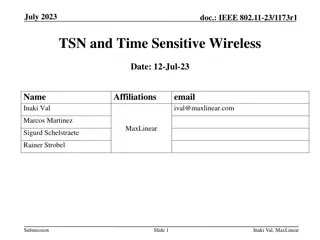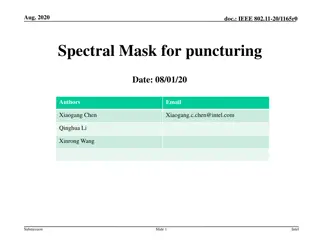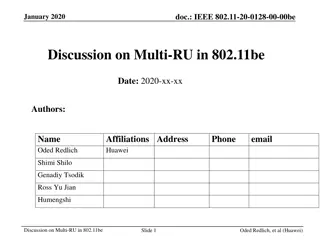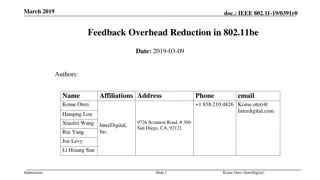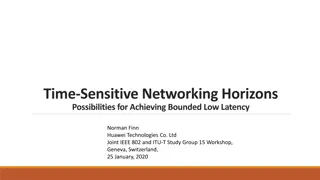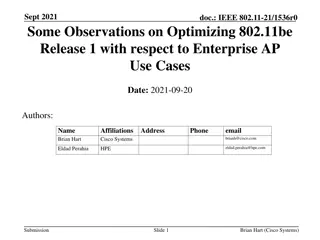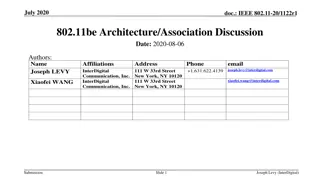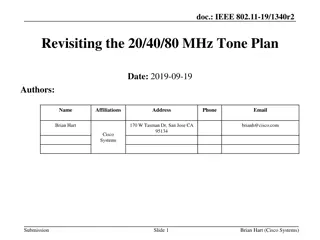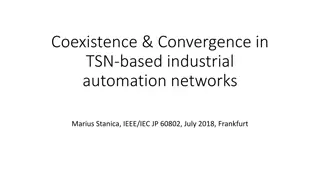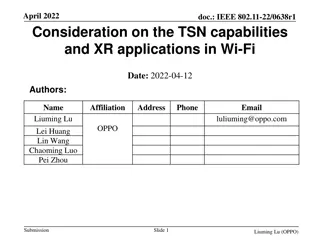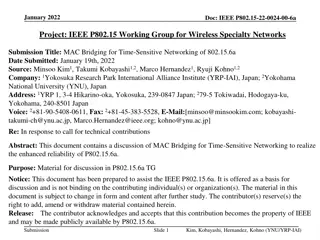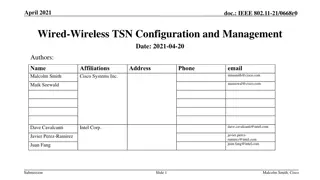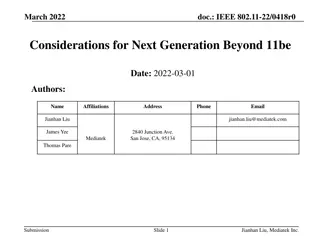Discussion on IEEE 802.11be Features for TSN Capabilities
IEEE 802.11be introduces features to support Time-Sensitive Networking (TSN) capabilities by enhancing throughput, traffic delivery paths, scheduling flexibility, and latency reduction. The standard addresses the stringent latency requirements of real-time applications, medium access protection, multi-link operation, interference management, and reliability prioritization. Specific issues related to multi-link operation, such as interference and throughput concerns, are also discussed.
Download Presentation

Please find below an Image/Link to download the presentation.
The content on the website is provided AS IS for your information and personal use only. It may not be sold, licensed, or shared on other websites without obtaining consent from the author.If you encounter any issues during the download, it is possible that the publisher has removed the file from their server.
You are allowed to download the files provided on this website for personal or commercial use, subject to the condition that they are used lawfully. All files are the property of their respective owners.
The content on the website is provided AS IS for your information and personal use only. It may not be sold, licensed, or shared on other websites without obtaining consent from the author.
E N D
Presentation Transcript
April 2021 doc.: IEEE 802.11-21/0681r0 Discussion on 802.11be features to support TSN capabilities Date: 2021-04-19 Authors: Name Liuming Lu Lei Huang Chaoming Luo Pei Zhou Affiliation Address Phone Email luliuming@oppo.com OPPO Submission Slide 1 Liuming Lu (OPPO)
April 2021 doc.: IEEE 802.11-21/0681r0 Introduction 802.11be has specified some features, which reduce worst case latency & jitter and provide more predictable latency and/or higher reliability, to support the delivery of the latency sensitive traffic as well as TSN applications. This contribution provides an overview of the currently specified features for reduced worst case latency to support TSN capabilities and potential extensions to be considered in 802.11be. Submission Slide 2 Liuming Lu (OPPO)
April 2021 doc.: IEEE 802.11-21/0681r0 802.11be Features to support TSN 1. Increase the throughput 2. Provide multiple paths for traffic delivery 3. Convenient for flexible Traffic scheduling Latency sensitive traffic has been defined in 802.11be Traffic originating from many real time applications has stringent latency requirements including not only very low average and worst case values within certain reliability constraints, of the order of a few to tens of milliseconds, but also small jitter. Enhance medium access protection and resource reservation 1. resource reservation 2. Convenient for flexible Traffic scheduling 802.11be Features 1. Increase the throughput 2.Enhance interference management between OBSSs TSN requirements Multi-link Operation Differentiate latency sensitive traffic from other traffic Restricted TWT (Target Wake Time ) Triggered TXOP sharing Low latency Prioritizes the transmission of latency sensitive traffic Spatial reuse operation Traffic differentiation 1. Increase the throughput 2. Enhance anti-interference & Reduce interference 3. Provide multiple paths for traffic delivery 4. Convenient for flexible traffic scheduling High Reliability Traffic Prioritization Multi-AP Operation 6GHz Operation Provide more manageable channels Submission Slide 3 Liuming Lu (OPPO)
April 2021 doc.: IEEE 802.11-21/0681r0 Multi-link operation - issues Issues Simultaneous Transmit and Receive across two links may cause the interference by out-of-band (OOB) emission unless their channels are sufficiently away. Multi-link operation is divided into two types: STR and NSTR ( Nonsimultaneous transmit and receive) operation. NSTR operation may be a general operation due to the low cost hardware requirement and limited operating frequency channels. Serval rules and mechanisms have currently been specified to solve the problems caused by NSR operation. PPDU end time alignment - rules for PPDU exchanges Start time sync PPDUs medium access - rules for simultaneous transmission Medium synchronization recovery procedure - mechanism to solve channel blindness issue Submission Slide 4 Liuming Lu (OPPO)
April 2021 doc.: IEEE 802.11-21/0681r0 Multi-link operation - issues Issues NSTR would decrease the throughput caused by the multi-link operation potentially. NSTR would reduce the flexibility of traffic scheduling across the multiple links. The restrictions on the NSTR operation would enlarge the transmission latency in order to follow the rules of the simultaneous transmission and PPDU end time alignment, and solve the blindness issue. Example According to the Non-STR MLD channel access procedure for Multi-link synchronous transmission when the backoff counter of one STA (STA1) in the MLD reaches zero but another STA (STA2) needs more time for backoff, STA1 cannot transmit MPDU and keep its backoff counter at zero. This would enlarge the transmission latency : The channel access opportunity is preempted by another STA(STA3) in the same link with STA1, therefore STA1 would lost its transmission opportunity. Submission Slide 5 Liuming Lu (OPPO)
April 2021 doc.: IEEE 802.11-21/0681r0 Multi-link operation - potential extensions Enrich the operation modes of multi-link synchronous transmission The currently specified rules for simultaneous transmission, such as start time sync PPDUs medium access, is mainly based on the operation of non-STR non-AP MLD by itself. For non-STR non-AP MLD to make the two STAs affiliated with the MLD finish their backoff procedure together and then transmit simultaneously is not a suitable method in some scenarios In order to reduce transmission latency it can be considered that AP MLD can assist the non-STR non-AP MLD to gain the transmission opportunities and implement the multi- link synchronous transmission. Expand the operation scenarios for trigger-based TXOP sharing. Trigger-based TXOP sharing can be used in multi-link synchronous transmission to assist the non-STR non-AP MLD to gain the transmission opportunities. Submission Slide 6 Liuming Lu (OPPO)
April 2021 doc.: IEEE 802.11-21/0681r0 Restricted TWT - issues Issues Whether the enhanced medium access protection of Restricted TWT is enough needs to be further considered. OBSS interferences may exist frequently and would affect the transmission during the TWT service periods (SPs). Only the non-AP EHT STA which supports Restricted TWT is required to end the TXOP before the start of the restricted TWT service periods in currently specified Restricted TWT. If there exists a non-AP EHT STA, which doesn t support Restricted TWT , it would not end its TXOP before the start of the restricted TWT SPs and therefore affect the transmission during the TWT SPs. If the restricted TWT SPs exist on one link of the NSTR pair of an MLD, the other transmission on the other link of the NSTR pair would affect the transmission on the link during the TWT SPs. Submission Slide 7 Liuming Lu (OPPO)
April 2021 doc.: IEEE 802.11-21/0681r0 Restricted TWT - potential extensions Further enhance the medium access protection of Restricted TWT Mechanism to mitigate the effect on the transmission during the TWT service periods (SPs), caused by the OBSS interferences. The usage of quiet element can be considered not to be limited to the intervals that overlap with restricted TWT service periods Rules can be considered to coordinate the transmission during the TWT service periods (SPs) on one link of the NSTR pair and the transmission on the other link for an MLD. Submission Slide 8 Liuming Lu (OPPO)
April 2021 doc.: IEEE 802.11-21/0681r0 Summary This contribution gives an overview of the currently specified 802.11be features for reduced worst case latency to support TSN capabilities, further analyzes the possible existing issues of the key features of multi-link operation and restricted TWT, and provides the potential extensions for the specification of the multi-link operation and restricted TWT to be considered in 802.11be. Submission Slide 9 Liuming Lu (OPPO)
April 2021 doc.: IEEE 802.11-21/0681r0 Reference [1] IEEE 802.11be Draft 0.4 [2] 11-21-0087-06-00be-pdt-mac-triggered-su [3] 11-19-1287-01-00be-tsn-support-in-802-11-and-potential- extensions-for-tgbe [4]11-19-1298-01-00be-ieee-802-1-tsn-an-introduction [5]11-21-0361-00-00be-ap-assisted-multi-link-synchronous- transmission Submission Slide 10 Liuming Lu (OPPO)










